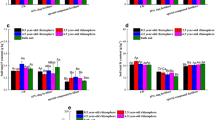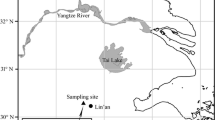Abstract
Purpose
Moso bamboo (Phyllostachys edulis), an important economic crop, is distributed from low- to medium-elevation mountains in Taiwan. Bamboo is a fast-growing herbaceous species with an extensive rhizome structure. With the hypothesis that the characteristics of soil organic matter and microbes might change after long-term bamboo plantation, we investigated different fractions of organic C and N as well as soil microbial biomass and activities in five moso bamboo plantations along an elevation gradient in Central Taiwan.
Materials and methods
Five soil samples (top 10 cm of soil) were collected from each bamboo plantation (600, 800, 1,000, 1,200, and 1,400 m above sea level (asl)) in January 2011. Soil was processed and analyzed for soil total C and N contents, biologically available C, potentially mineralizable N, soil microbial biomass and soil respiration (CO2). Two extraction methods (2 M KCl and hot-water extraction) were used to estimate soil soluble organic C and N (SbOC and SbON) and soil inorganic N (NH4 + and NO3 −) concentrations to evaluate the relationship with soil organic matter and microbe characteristics in bamboo plantations.
Results and discussion
Soil total C and N contents as well as soil microbial biomass and soil respiration (CO2) of the bamboo plantations increased along the elevation gradient. Temperature changes along elevation contributed to such variations observed among the selected bamboo plantations. The SbON in hot-water extracts was highest in the 1,200-m plantation, then in the 1,400-m plantation, and lowest in the low-elevation plantations (600, 800, and 1,000 m). However, SbON in 2 M KCl extracts did not differ by elevation. The SbON was strongly correlated with soil total N in both 2 M KCl and hot-water extracts, but only SbON in hot-water extracts was strongly correlated with microbial biomass N and potentially mineralizable N. SbOC was strongly correlated with soil total C content, microbial biomass C, and biologically available C in both 2 M KCl and hot-water extracts.
Conclusions
Soil total C and N, SbOC and SbON, and microbial biomass characteristics increased in the moso bamboo plantations with increasing elevation. No altitudinal difference in specific soil respiration (CO2) rate suggested that the enhanced potentially mineralizable N and soil respiration (CO2) in the high-elevation plantations were associated with increased microbial biomass rather than microbial activities.




Similar content being viewed by others
References
Alef K (1991) Methodology handbook of soil microbiology: activity-biomass-differentiation. Ecomed, Landsberg
Amato M, Ladd JN (1988) Assay for microbial biomass based on ninhydrin-reactive nitrogen in extracts of fumigated soils. Soil Biol Biochem 20:107–114
Anderson TH, Domsch KH (1993) The metabolic quotient for CO2 (qCO2) as a specific parameter to assess the effects of environmental conditions, such as pH, on the microbial biomass of forest soils. Soil Biol Biochem 25:393–395
Chen CR, Xu ZH (2008) Analysis and behavior of soluble organic nitrogen in forest soils. J Soils Sediments 8:363–378
Chen CR, Xu ZH, Zhang SL, Keay P (2005) Soluble organic nitrogen pools in forest soils of subtropical Australia. Plant Soil 277:285–297
Chou CH, Yang CM (1982) Allelopathic research of subtropical vegetation in Taiwan. II. Comparative exclusion of understory by Phyllostachys edulis and Cryptomeria japonica. J Chem Ecol 8:1489–1507
Curtin D, Campbell CA (2007) Mineralizable nitrogen. In: Carter MR, Gregorich EG (eds) Soil sampling and methods of analysis, 2nd edn. CRC, Boca Raton, pp 299–606
Garten CT Jr (2004) Potential net soil N mineralization and decomposition of glycine-13C in forest soils along an elevation gradient. Soil Biol Biochem 36:1492–1496
Garten CT Jr, Hanson PJ (2006) Measured forest soil C stocks and estimated turnover times along an elevation gradient. Geoderma 136:342–352
Garten CT Jr, Post WM, Hanson PJ, Cooper LW (1999) Forest soil carbon inventories and dynamics along an elevation gradient in the southern Appalachian Mountains. Biogeochemistry 45:115–145
Inubushi K, Brookes PC, Jenkinson DS (1991) Soil microbial biomass C, N and ninhydrin-N in aerobic and anaerobic soils measured by the fumigation-extraction method. Soil Biol Biochem 23:737–741
Jiang PK, Xu QF (2006) Abundance and dynamics of soil labile carbon pools under different types of forest vegetation. Pedosphere 16:505–511
Jiang P, Wang H, Wu J, Xu Q, Zhou G (2009) Winter mulch increases soil CO2 efflux under Phyllostachys praecox stands. J Soils Sediments 9:511–514
Kalbitz K, Schwesig D, Schmerwitz J, Kaiser K, Haumaier L, Glaser B, Ellerbrock R, Leinweber P (2003) Changes in properties of soil-derived dissolved organic matter induced by biodegradation. Soil Biol Biochem 35:1129–1142
Kirschbaum MUF (2000) Will changes in soil organic carbon act as a positive or negative feedback on global warming? Biogeochemistry 48:21–51
Liu J, Jiang P, Wang H, Zhou G, Wu J, Yang F, Qian X (2011) Seasonal soil CO2 efflux dynamics after land use change from a natural forest to moso bamboo plantations in subtropical China. For Ecol Manag 262:1131–1137
Lu S, Chen C, Zhou X, Xu Z, Bacon G, Rui Y, Guo X (2012) Responses of soil dissolved organic matter to long-term plantations of three coniferous tree species. Geoderma 170:136–143
Mountain Agricultural Resources Development Bureau (MARDB) (1984) Soil survey report of Nantou and Chunghua County. Agriculture and Forestry Division, Mountain Agricultural Resources Development Bureau, R.O.C. pp 143
Murphy DV, Macdonald AJ, Stockdale EA, Goulding KWT, Fortune S, Gaunt JL, Poulton PR, Wakefield JA, Webster CP, Wilmer WS (2000) Soluble organic nitrogen in agricultural soil. Biol Fertil Soils 30:374–387
Neff JC, Chapin FS III, Vitousek PM (2003) Breaks in the cycle: dissolved organic nitrogen in terrestrial ecosystems. Front Ecol Environ 1:205–211
Okutomi K, Shinoda S, Fukuda H (1996) Causal analysis of the invasion of broad-leaved forest by bamboo in Japan. J Veg Sci 7:723–728
Podwojewski P, Poulenard J, Nguyet ML, de Rouw A, Nguyen VT, Pham QH, Tran DT (2011) Climate and vegetation determine soil organic matter status in an alpine inner-tropical soil catena in the Fan Si Pan Mountain, Vietnam. Catena 87:226–239
Ros GH, Hoffland E, van Kessel C, Temminghoff EJM (2009) Extractable and dissolved soil organic nitrogen—a quantitative assessment. Soil Biol Biochem 41:1029–1039
Rustad LE, Campbell JL, Marion GM, Norby RJ, Mitchell MJ, Hartley AE, Cornelissen JHC, Gurevitch J (2001) A meta-analysis of the response of soil respiration, net nitrogen mineralization, and aboveground plant growth to experimental ecosystem warming. Oecologia 126:543–562
Scaglia B, Adani F (2009) Biodegradability of soil water soluble organic carbon extracted from seven different soils. J Environ Sci 21:641–646
Shanks RE (1954) Climates of the Great Smoky Mountains. Ecology 35:354–361
Sheiner D (1976) Determination of ammonia and Kjeldahl nitrogen by indophenols method. Water Res 10:31–36
Singh JS, Raghubanshi AS, Singh RS, Srivastava SC (1989) Microbial biomass acts as a source of plant nutrients in dry tropical forest and savanna. Nature 338:499–500
Soil Survey Staff (2010) Keys to soil taxonomy. USDA-NRCS, Agricultural Handbook No. 436, 11th ed., U.S. Government Printing Office, Washington, DC, USA
Tripathi SK, Singh KP (1994) Productivity and nutrient cycling in recently harvested and mature bamboo savannas in the dry tropics. J Appl Ecol 31:109–124
Tripathi KP, Singh KP, Singh PK (1999) Temporal changes in spatial pattern of fine-root mass and nutrient concentrations in Indian bamboo savanna. Appl Veg Sci 2:229–238
Vance ED, Brookes PC, Jenkinson DS (1987) An extraction method for measuring soil microbial biomass C. Soil Biol Biochem 19:703–707
Waring SA, Bremner JM (1964) Ammonium production in soil under waterlogged conditions as an index of nitrogen availability. Nature 201:951–952
Wu J, Joergensen RG, Pommerening B, Chaussod R, Brookes PC (1990) Measurement of soil microbial biomass C by fumigation–extraction—an automated procedure. Soil Biol Biochem 22:1167–1169
**ng S, Chen C, Zhou B, Zhang H, Nang Z, Xu Z (2010) Soil soluble organic nitrogen and active microbial characteristics under adjacent coniferous and broadleaf plantation forests. J Soils Sediments 10:748–757
Xu Q, Jiang P, Xu Z (2008) Soil microbial functional diversity under intensively managed bamboo plantations in southern China. J Soils Sediments 8:177–183
Yang Y, Wang K, Pei S, Hao J (2004) Bamboo diversity and traditional uses in Yunnan, China. Mt Res Dev 24:157–165
Acknowledgments
This work was supported in part by the National Science Council, Taiwan (NSC 101-2621-B-001-002-MY3).
Author information
Authors and Affiliations
Corresponding author
Additional information
Responsible editor: Zucong Cai
Rights and permissions
About this article
Cite this article
Huang, CY., Jien, SH., Chen, TH. et al. Soluble organic C and N and their relationships with soil organic C and N and microbial characteristics in moso bamboo (Phyllostachys edulis) plantations along an elevation gradient in Central Taiwan. J Soils Sediments 14, 1061–1070 (2014). https://doi.org/10.1007/s11368-014-0870-z
Received:
Accepted:
Published:
Issue Date:
DOI: https://doi.org/10.1007/s11368-014-0870-z




